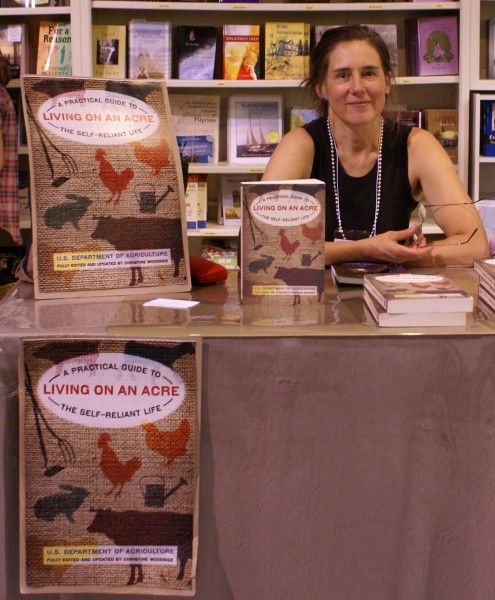Chris at the Big E Connecticut writers’ table with ‘Living on an Acre’
Go Forward by Going Back in Time

Homesteading fever gripped many Americans in the 1970s. The movement got its fuel from energy shortages, the environmental movement, and a recession.
The United States Department of Agriculture, perhaps sensing that new enthusiasts might not know what they were getting into, decided to devote its yearbook of agriculture for 1978 to the movement. They called the book Living on a Few Acres. The USDA’s yearbooks of agriculture compiled the best advice for anyone who desired to learn from 1894 through 1992, when, unfortunately, they ceased publication. The yearbooks even now make a distinguished set of themed guidebooks for farmers, would-be farmers, and anyone who wanted to understand soil, climate, growing, and raising.
The 1978 volume followed that pattern by laying out practical, general advice from experts who talked almost as if they had stopped by your house to chat. Living on a Few Acres, edited by Jack Hayes, addressed people who wanted to try farming on a small scale and experienced farmers scaling back to part-time work for retirement.
For Lyons Press, I edited that volume and brought it up-to-date. I worked hard to leave intact the blunt yet sympathetic tone of that book while adding new data and sources. The 1970s were such an enthusiastic time. They were also a slightly nutty time. Everyone had a dream that could be found embroidered on a decorative pillow.
The author of the foreword was then-Secretary of Agriculture Bob Bergland. I have brought his history up to date, but many of his sentences unfold untouched. His advice to test yourself and enjoy the freedom of making a living from the land holds up today. He understood that this could be very difficult. He was himself a farmer.
A. Gene Nelson co-authored the important first two chapters about what it’s like to live in the country and considering the tradeoffs of leaving the city. At the time he was an extension farm management specialist at Oregon State University. Since 1990 he has been a professor of agricultural economics at Texas A & M University. I was able to get in touch with him, and he wrote: “Now that the USDA has discontinued publishing these yearbooks, you are providing a service by updating them. Much of the information is probably still relevant.”
Although we renamed this book Living on an Acre to reflect the shrinking size of country tracts, it serves the same purpose as the original. This is a practical guide to several enterprises. It is mainly for those who have not tried this experiment before, most of whom will keep their jobs in town (or in a home office, perhaps) or will live off a pensions or investments. Ninety percent of farm income in the United States comes from off-farm employment. If only it weren’t true, but that is the way it is. Really small farms, under 10 acres, make up about 10 percent of all farms in America. Think of that—an important minority of a vital industry supports itself on capital earned away from the farm.
Contents
Foreword: The New Back-to-the-Land Movement
Part 1: Pluses and Minuses
Living in the Country—a Diversity of People
Consider the Trade-Offs Before Leaving the City
Face the Realities
Changing to a New Lifestyle: Little Things Add Up
Part 2: Acquiring That Spot
Selecting a Community
Alternative Rural Communities
Making Your Final Choice
Part 3: Improvements for Your Place
Remodeling a House—Will It Be Worthwhile?
A Personal Experience
Building That Dream House: Don’t Be Caught Napping
Work and Storage Areas Outside
Landscaping: Get Help, Plan Carefully
Land Improvements—What You Need to Know
Your Farmstead Buildings
Water and Waste Disposal
Power Sources and Equipment
Part 4: The Big Picture
Five Years on Five Acres
Welcome to SweetAire Farm
Pigs and Pumpkins
The View from Golden Hill Farm
Attracting Wildlife to Your Land
The Benefit of a Woodlot
Part 5: Growing and Raising:
How to Do It
Fruit Trees
Grapes
Four Kinds of Berries
Vegetables
Organic Food
How to Market Produce
Ornamental Plants
A Plant Nursery
Dried Flower Arrangements
Herbs
Greenhouse Gardening
Beekeeping
Christmas Trees
Raising Pigs
Walnuts, Pecans, and Chestnuts
Chickens and Other Fowl
Rabbits
Beef Cattle
Raising Sheep
Dairy Cows
Dairy Goats
Horses
Vacation Farms
Dude Ranches
Part 6: Property
Disposing of Property
Transferring Land with Preservation in Mind
Providing for Your Heirs
How to Get Help
